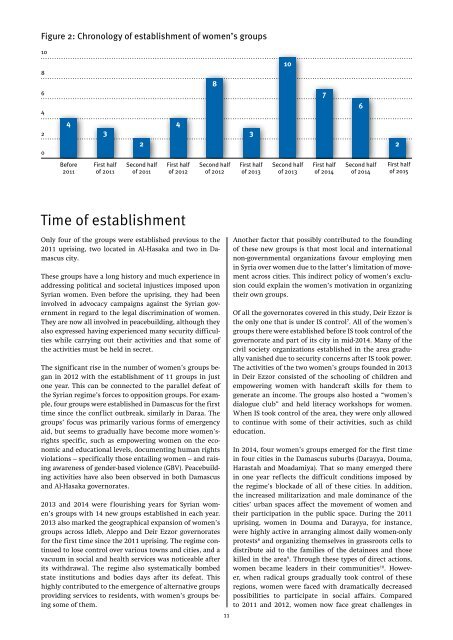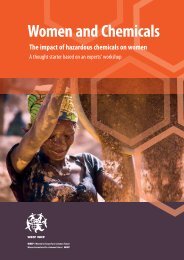future now”
YAO19
YAO19
Create successful ePaper yourself
Turn your PDF publications into a flip-book with our unique Google optimized e-Paper software.
Figure 2: Chronology of establishment of women’s groups<br />
10<br />
10<br />
8<br />
8<br />
6<br />
7<br />
4<br />
6<br />
2<br />
4<br />
3<br />
4<br />
3<br />
2 2<br />
0<br />
Before<br />
2011<br />
First half<br />
of 2011<br />
Second half<br />
of 2011<br />
First half<br />
of 2012<br />
Second half<br />
of 2012<br />
First half<br />
of 2013<br />
Second half<br />
of 2013<br />
First half<br />
of 2014<br />
Second half<br />
of 2014<br />
First half<br />
of 2015<br />
Time of establishment<br />
Only four of the groups were established previous to the<br />
2011 uprising, two located in Al-Hasaka and two in Damascus<br />
city.<br />
These groups have a long history and much experience in<br />
addressing political and societal injustices imposed upon<br />
Syrian women. Even before the uprising, they had been<br />
involved in advocacy campaigns against the Syrian government<br />
in regard to the legal discrimination of women.<br />
They are now all involved in peacebuilding, although they<br />
also expressed having experienced many security difficulties<br />
while carrying out their activities and that some of<br />
the activities must be held in secret.<br />
The significant rise in the number of women’s groups began<br />
in 2012 with the establishment of 11 groups in just<br />
one year. This can be connected to the parallel defeat of<br />
the Syrian regime’s forces to opposition groups. For example,<br />
four groups were established in Damascus for the first<br />
time since the conflict outbreak, similarly in Daraa. The<br />
groups’ focus was primarily various forms of emergency<br />
aid, but seems to gradually have become more women’srights<br />
specific, such as empowering women on the economic<br />
and educational levels, documenting human rights<br />
violations – specifically those entailing women – and raising<br />
awareness of gender-based violence (GBV). Peacebuilding<br />
activities have also been observed in both Damascus<br />
and Al-Hasaka governorates.<br />
2013 and 2014 were flourishing years for Syrian women’s<br />
groups with 14 new groups established in each year.<br />
2013 also marked the geographical expansion of women’s<br />
groups across Idleb, Aleppo and Deir Ezzor governorates<br />
for the first time since the 2011 uprising. The regime continued<br />
to lose control over various towns and cities, and a<br />
vacuum in social and health services was noticeable after<br />
its withdrawal. The regime also systematically bombed<br />
state institutions and bodies days after its defeat. This<br />
highly contributed to the emergence of alternative groups<br />
providing services to residents, with women’s groups being<br />
some of them.<br />
11<br />
Another factor that possibly contributed to the founding<br />
of these new groups is that most local and international<br />
non-governmental organizations favour employing men<br />
in Syria over women due to the latter’s limitation of movement<br />
across cities. This indirect policy of women’s exclusion<br />
could explain the women’s motivation in organizing<br />
their own groups.<br />
Of all the governorates covered in this study, Deir Ezzor is<br />
the only one that is under IS control 7 . All of the women’s<br />
groups there were established before IS took control of the<br />
governorate and part of its city in mid-2014. Many of the<br />
civil society organizations established in the area gradually<br />
vanished due to security concerns after IS took power.<br />
The activities of the two women’s groups founded in 2013<br />
in Deir Ezzor consisted of the schooling of children and<br />
empowering women with handcraft skills for them to<br />
generate an income. The groups also hosted a “women’s<br />
dialogue club” and held literacy workshops for women.<br />
When IS took control of the area, they were only allowed<br />
to continue with some of their activities, such as child<br />
education.<br />
In 2014, four women’s groups emerged for the first time<br />
in four cities in the Damascus suburbs (Darayya, Douma,<br />
Harastah and Moadamiya). That so many emerged there<br />
in one year reflects the difficult conditions imposed by<br />
the regime’s blockade of all of these cities. In addition,<br />
the increased militarization and male dominance of the<br />
cities’ urban spaces affect the movement of women and<br />
their participation in the public space. During the 2011<br />
uprising, women in Douma and Darayya, for instance,<br />
were highly active in arranging almost daily women-only<br />
protests 8 and organizing themselves in grassroots cells to<br />
distribute aid to the families of the detainees and those<br />
killed in the area 9 . Through these types of direct actions,<br />
women became leaders in their communities 10 . However,<br />
when radical groups gradually took control of these<br />
regions, women were faced with dramatically decreased<br />
possibilities to participate in social affairs. Compared<br />
to 2011 and 2012, women now face great challenges in



